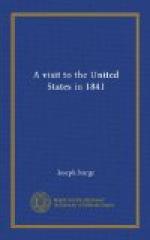An event so extraordinary and unprecedented as the capture of the “Amistad,” excited the most lively interest among all classes. The Africans, forty-four in number, were brought to New Haven and secured in the county jail. A number of gentlemen formed themselves into a committee to watch over their interests, and immediately there was begun a long and complicated series of judicial proceedings, to determine how they should be disposed of. Ruiz and Montez, the two white men, late the prisoners, but claiming to be the owners of the Africans, caused them to be indicted for piracy and murder. This was almost immediately disposed of, on the ground that the charges, if true, were not cognizable in the American courts, the alleged offences having been perpetrated on board a Spanish vessel. The Africans therefore were in no immediate danger of capital punishment. Ruiz and Montez on their part seem to have met with sympathy and kindness, and to testify their gratitude caused the following to be inserted in the New York papers:
“A CARD.
“NEW LONDON, AUGUST 29, 1839.
“The subscribers, Don Jose Ruiz, and Don Pedro Montez, in gratitude for their most unhoped for and providential rescue from the hands of a ruthless gang of African bucaneers and an awful death, would take this means of expressing, in some slight degree, their thankfulness and obligation to Lieut. Com. T.R. Gedney, and the officers and crew of the U.S. surveying brig Washington, for their decision in seizing the Amistad, and their unremitting kindness and hospitality in providing for their comfort on board their vessel, as well as the means they have taken for the protection of their property.
“We also must express our indebtedness to that nation whose flag they so worthily bear, with an assurance that this act will be duly appreciated by our most gracious sovereign, her Majesty the Queen of Spain.
DON JOSE, RUIZ,
DON PEDRO MONTEZ.”
Ruiz and Montez are thus described by a correspondent of the New London Gazette, who visited the Amistad immediately after its capture:




